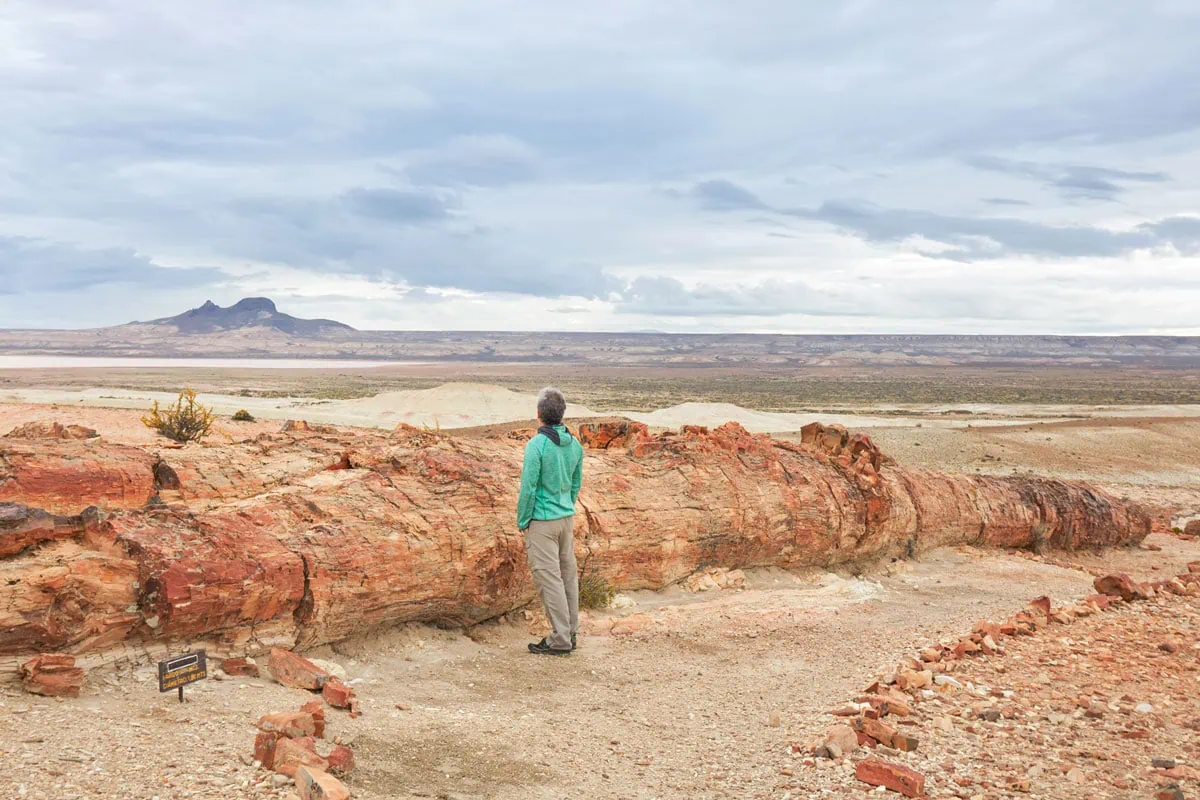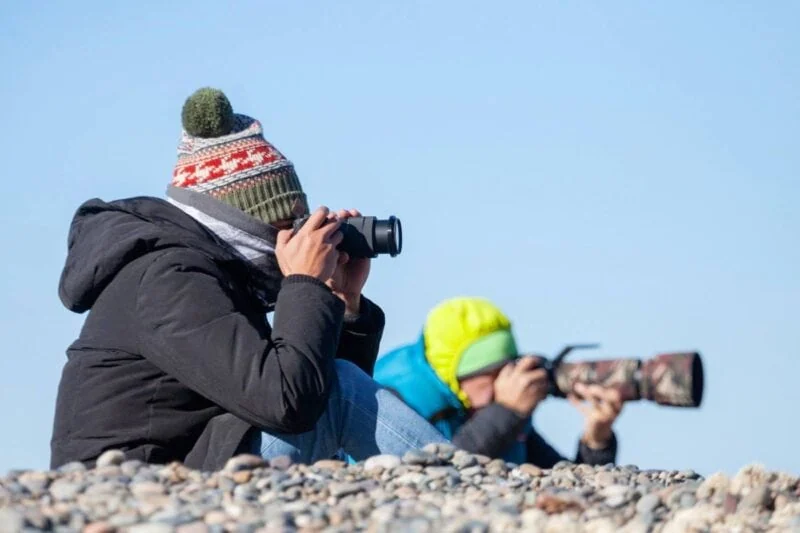

ORIGINS OF PATAGONIA
Photo Workshop along the Ruta Mara
NEXT GROUP DATE:
12 to 15 November 2026
- INFO
- ITINERARY
- PRICE / INCLUDED
- BOOKING CONDITIONS
Ruta Mara: Patagonia Off the Beaten Path
-
GENRE
Landscape, Culture
-
BEST TRAVEL PERIOD
October to February
-
DIFFICULTY
Easy
-
GROUP
Max 8
-
GENRE
Landscape, Culture
-
BEST TRAVEL PERIOD
October to February
-
DIFFICULTY
Easy
-
GROUP
Max 8
Join us for an unforgettable 4-Day Photography Adventure into the wild, remote heart of Patagonia, along the Ruta Mara (Macizo del Deseado).
Our journey will take you deep into the surreal landscapes of the Bosques Petrificados de Jaramillo National Park, where ancient fossilized Araucaria trees whisper the secrets of a prehistoric world. We’ll wander through a timeless Patagonian town, its weathered facades, trees sculpted by the force of the wind, and slow rhythms offering endless stories to capture.
Venture even further back in time as we explore indigenous caves, bearing witness to art and marks etched by civilizations far older than those of the famed “Cueva de las Manos”. Marvel at the raw beauty of the Sierras Blancas rock formation, where light and shadow sculpt dramatic natural cathedrals.
Our home for this expedition will be a remote Patagonian Estancia, nestled in the wide-open steppe. Here, you’ll have the opportunity to photograph a gaucho in his environment—herding livestock, riding across vast plains, and living traditions that have remained unchanged for generations.
Every moment is designed to immerse you fully in the Untamed Soul of Patagonia, blending storytelling, nature, culture, and adventure into an experience that will not only sharpen your photographic vision but leave you forever changed.
Are you ready to capture Patagonia at its purest?

To book flights, please contact us before, we will help you coordinate schedules and transportation to get there. The nearest city is Comodoro Rivadavia.

Transportation to Comodoro Rivadavia is not included in the trip, and we will not be responsible for any delays or disruptions that are beyond our control. In any case, we will do what we can, given the circumstances, to help you.
We begin our adventure with an early morning arrival at Comodoro Rivadavia Airport. From there, we’ll journey along the dramatic Atlantic coast, where towering cliffs meet the restless sea, and—with a bit of luck—we might spot sea lionsbasking on the shores.
Our route will then take us inland to the historic town of Jaramillo, a charming settlement that still carries the spirit of Patagonia’s golden age of railways. Here, among traditional Patagonian houses and echoes of a bygone era, we’ll pause for a hearty lunch.
In the afternoon, we continue toward the awe-inspiring Bosques Petrificados de Jaramillo. Along the way, we’ll make several stops to photograph the volcanoes and the striking landscapes of the Patagonian plateau—a place where vastness and silence reign.
By evening, we’ll arrive at our remote Patagonian estancia, our home for the night. After settling in, we’ll gather for a welcome dinner, sharing stories under the wide southern sky.
After a good breakfast, we dive into the heart of Patagonian tradition. Guided by our local gaucho, we’ll learn the intricate art of managing a wool farm, experiencing firsthand the centuries-old techniques of sheep herding and Merino wool shearing. This is a rare opportunity to connect with a way of life shaped by patience, skill, and deep respect for the land.
Following a well-deserved lunch, we’ll continue with troop handling demonstrations, witnessing both traditional taming methods and the ancient techniques of Tehuelche horsemanship—a living link to Patagonia’s indigenous heritage.
As the day winds down, we’ll enjoy a classic aperitif while a lamb “a la cruz” slowly roasts over the open fire, filling the air with the rich aromas of a true Patagonian feast.
Later, as the stars ignite across the vast southern sky, we’ll venture into the open fields for an unforgettable session of night photography, capturing the magic of Patagonia under a blanket of stars.
After breakfast, we set out to explore ancient indigenous caves, whose mysterious paintings and engravings predate even the famous Cueva de las Manos. Here, surrounded by silence and stone, we’ll connect with the timeless spirit of Patagonia’s first inhabitants.
For lunch, we’ll relax in a peaceful meadow of fruit trees, enjoying a serene break under the wide Patagonian sky.
In the afternoon, we’ll visit a historic estancia, a relic of Patagonia’s pioneering days, where the architecture and atmosphere tell stories of endurance and solitude.
Our journey continues to the stunning Sierras Blancas, an otherworldly landscape of white rock formations carved by centuries of wind and time. As the sun lowers, we’ll capture the changing light painting the rocks in shades of gold and crimson—an unforgettable sunset session on our way back to the estancia.
We’ll end the day with a warm dinner, sharing stories and images from a day filled with history, beauty, and wonder.
After breakfast, we’ll spend a relaxed morning at the estancia, capturing gaucho activities in their most authentic form. This is your chance to create intimate portraits and dynamic scenes, using provided lighting equipment to elevate your shots and tell the story of life on the Patagonian steppe.
We will share a last lunch together on the road, savoring the essence of these wild lands, and then we will continue our trip back to the Comodoro Rivadavia Airport. Flights are scheduled for the evening (around 8 PM).
IMPORTANT
The itinerary published on this page and on our PDFs/brochures is indicative. The guide reserves the right to make changes without prior notice, which may depend on various factors/events such as weather, geography, protests, medical emergencies, etc.
Changes are aimed at ensuring the safety of travelers and the success of the trip, always trying to maintain the proposed activities.
At the estancia, internet access is available for just one hour each day, offering a rare chance to truly disconnect from technology. Surrounded by the vast, untamed beauty of Patagonia, you’ll find it the perfect opportunity to slow down, reconnect with nature, and fully immerse yourself in the experience.
Price (based on 6 participants):
1.560 USD (Double/Shared Occupancy)
Single Supplement not available.
There is no price difference between the double and shared base. There are only 2 double rooms available in the estancia, the other room is shared.
What's included?
- Professional Photographer
- Small Group Size
- Transportation in 4x4 Off-Road Vehicle
- Analysis of the Work Done
- Estancia accommodation for 3 Nights
- All Excursions and Photography Activities
- All Meals
What's not!
- Transport from your origin point to Comodoro Rivadavia
- Travel & Medical Insurance (optional, but recommended)
- Personal Expenses
- Tips
Bookings
To book a workshop we ask for 30% deposit of the total.
The workshop balance must be paid 45 days before the start date. You can also pay in cash (USD or euros) upon arrival.
Cancellations & Refunds
For a workshop cancellation, a written notice is required. Please email your request to info@argentinaphotoworkshops.com.
We acknowledge the commitment involved in attending our workshops and strive to accommodate unforeseen circumstances.
Please review our Cancellation Policy below:
• Cancellation made more than 181 days before the workshop start date: 20% refund of any payments made.
• Cancellation made less than 180 days before the workshop start date: No refund of any payments made.
Please note the following:
• In the event that you are unable to attend, your paid balance will be credited for 1 year (from the date of the cancelled trip) as part of the payment of a workshop of your choice.
If the amount was paid in Argentine pesos, the equivalent in US dollars will be credited subject to the exchange rate on the day the trip was cancelled.
In case the workshop is cancelled by Argentina Photo Workshops due to reasons of force majeure:
• There will be a complete refund of the amount deposited.

5% EARLY BIRD DISCOUNT
Applies for bookings made more than 8 months in advance of the start date.
RECOMMENDED EQUIPMENT
Check out our guide on “How to Prepare for a Photography Workshop”, as well as information on equipment and FAQs below.
Near the date of the workshop, we will be in touch through a WhatsApp group, an ideal space to answer all kinds of questions before the trip and organize every detail. If necessary (upon request) we will also arrange a group video call via Google Meet for this purpose.
Although you can participate with any type of photographic device, we recommend a reflex or mirrorless camera, which allow much more freedom and creativity.
Considering the wide variety of photographic situations this workshop presents, it is advisable to have available focal lengths ranging from wide-angle (shorter distances) to telephoto (longer distances).
For Portraits, we recommend a lens ranging from 70mm to 200mm. The 85mm is usually regarded as one of the best lenses dedicated to portraiture.
For Landscape Photography, we suggest a wide focal lenght: ideally around 15 – 50 mm. You can also get a good landscape with a longer focal length by using a stable tripod.
For night photos (Astrophotography) the shorter the focal length, the better. This makes it possible to include more elements in the frame.
For terrestrial wildlife, a 300mm or longer telephoto lens is the best choice.
Consider also buying a tele converter to increase the focal length of the lens: 1.4x or 2x. Even if with loss of luminosity.
Finally, choosing the right set of lenses is not easy. If you encounter difficulties and need some suggestions do not hesitate to contact us.
Many of the areas we visit are remote, and it is possible to fly the drone, always keeping the proper precautions and at a distance from crowds of people, airports and helicopter landing strips. Excluding the National Parks.
The most important feature of a tripod is its stability. Since every journey includes some trekking, we must also take into account the weight.
We suggest a good carbon tripod that maintains a good balance between weight and stability, that can easily change from one height to another and that locks in little space.
Aluminum is also fine, as carbon is generally much more expensive. We know that choosing a tripod is not easy and we are available to help you choose the right model for you.
A Polarizing filter will be very useful to neutralize water reflections in the lagoons.
For those who love Landscape Photography, ND filters with 6 or 8 steps will be also very useful to play with the movement of water and clouds.
It is recommended to carry UV or Skylight filters, useful to protect the lenses from Ultraviolet rays (even more important in these altitudes), dust and splashes.
Finding the right photo backpack can be a difficult challenge. We recommend you to rely on a brand with quality and experience in the market.
The type of backpack clearly depends on your equipment. But what really matters is that you feel comfortable with it and possibly fitted with a rain cover.
You can’t miss in your backpack: a cleaning kit for the lenses, a remote control to shoot without touching the camera, hood for the lenses (to avoid flare) and a robust / comfortable camera strap.
It is also important to take spare batteries with you, as they tend to discharge faster with low mountain temperatures.
If you are interested in POST-PRODUCTION we suggest bringing your laptop with some editing software already installed. The Lead Photographer, at the end of the day, will answer your questions.
PATAGONIA PHOTO TOUR FAQ
Of course, accompanying non-photographers are welcome. The price is the same.
Usually in a Photo Tour the Leading Photographers accompany to locations only, while in a Workshop you are also expected to receive technical notions to improve your photography. Both options, often confusing, are good. It depends on what one is looking for. Our activities are developed in both modes, depending on the trip.
The Macizo del Deseado, located in northern Santa Cruz Province, Argentina, is a geologically and ecologically significant region on the Patagonian Plateau. While it’s primarily known for its volcanic and fossil-rich landscapes, it also supports a variety of Patagonian steppe and semi-arid wildlife. Wildlife you can expect to spot in the Macizo del Deseado area includes:
Mammals
Guanaco (Lama guanicoe): The most common large herbivore in the region.
Patagonian mara (Dolichotis patagonum): A large rodent resembling a small deer.
Puma (Puma concolor): Present but elusive; signs like tracks are more commonly found than the animal itself.
Geoffroy’s cat (Leopardus geoffroyi): A small wild cat native to southern South America.
Culpeo fox (Lycalopex culpaeus): A common predator in Patagonian environments.
Birds
Andean condor (Vultur gryphus): Occasionally seen soaring over cliffs and canyons.
Lesser rhea (Rhea pennata or ñandú petiso): A flightless bird similar to an ostrich.
Southern crested caracara (Caracara plancus): A common scavenger.
Patagonian tinamou (Tinamotis ingoufi): Ground-dwelling bird often heard before seen.
Burrowing owl (Athene cunicularia): Nests in burrows on the open steppe.
Flamingos (Phoenicopterus chilensis): Found in nearby saline lakes like those around the Deseado River basin.
Reptiles and Amphibians
Liolaemus lizards: Several species thrive in the dry, rocky environment.
Patagonian toad (Rhinella arenarum): Found near water bodies, though less common in arid sections.
Invertebrates and Others
While less visible, the area hosts endemic insects and spiders adapted to its harsh climate.
The Macizo del Deseado is also notable for its paleontological value, so while you’re observing living wildlife, you might also come across fossil remains of prehistoric fauna.
The weather in the Macizo del Deseado area is typical of the Patagonian steppe—dry, windy, and harsh, with wide temperature fluctuations. Here’s a breakdown of what you can expect:
General Climate
Semi-arid to arid: Low annual precipitation (100–300 mm/year).
Very windy: Strong westerly winds are common year-round.
High solar radiation: Due to clear skies and latitude.
Summer (December to February)
Daytime highs: 20–30°C (68–86°F)
Nights: Can drop below 10°C (50°F)
Conditions: Dry, windy, and very sunny. Heat can be intense during the day but drops quickly after sunset.
Autumn (March to May)
Milder temperatures: 10–20°C (50–68°F) during the day
Increasing cold at night
Less wind than summer, but still notable
Winter (June to August)
Daytime highs: 0–10°C (32–50°F)
Nights: Often below freezing
Snow: Rare but possible
Conditions: Cold, dry, and windy
Spring (September to November)
Temperatures rising gradually
Very windy
Dry with occasional sudden weather changes
The combination of high winds, strong UV exposure, and cool nights means it’s important to dress in layers, use sun protection, and bring windproof gear—especially if you’re camping or exploring on foot.
Here is a list of recommended clothing for the Patagonia Workshop:
- Waterproof Hiking Boots
- Comfortable Trainers
- Thermal Clothes (T-shirt and underpants)
- Lightweight and breathable long-sleeved shirt and T-shirt for UV protection
- Sunglasses for UV Protection
- Hat, gloves and neck cover
- Windproof and rainproof jacket and trousers
The round trip between your city of origin and Comodoro Rivadavia is not included in the price.
However, we can help you coordinate it.
These activities require a lot of organization and are prepared well in advance. Weather is a factor we can’t predict, so the workshop/photo tour is not cancelled.
In any case, we will always be attentive to weather conditions to optimize the program and try to provide the best light conditions for photography.
Get more information about the Photo Tour, such as the cost of the next group workshop or a quote for a private adventure, just for you / your group.
GET MORE INFO
Join this Adventure!
RELATED ARTICLES
How to Prepare for a Photography Workshop: Ultimate Guide
Photography Workshops offer an invaluable opportunity to enhance your skills,...
Read More
